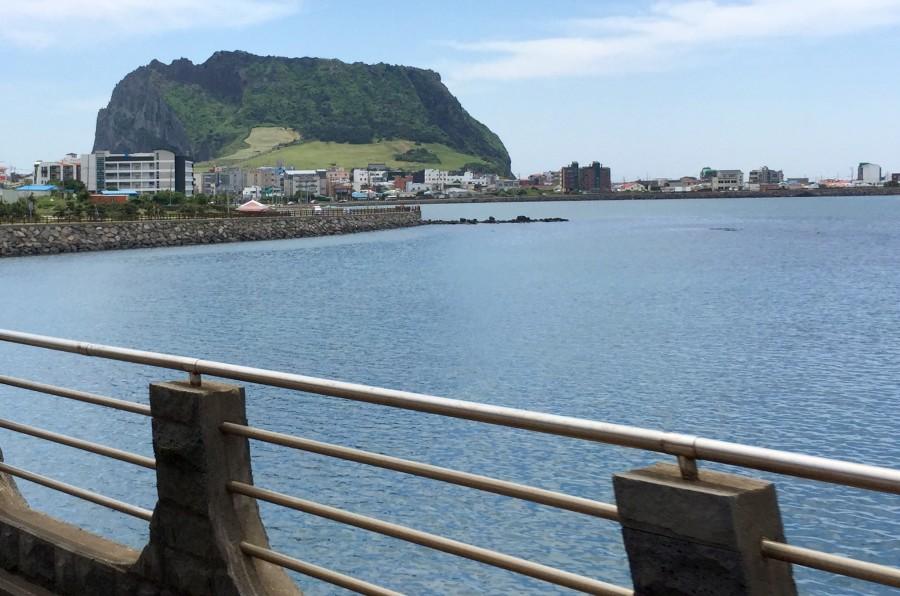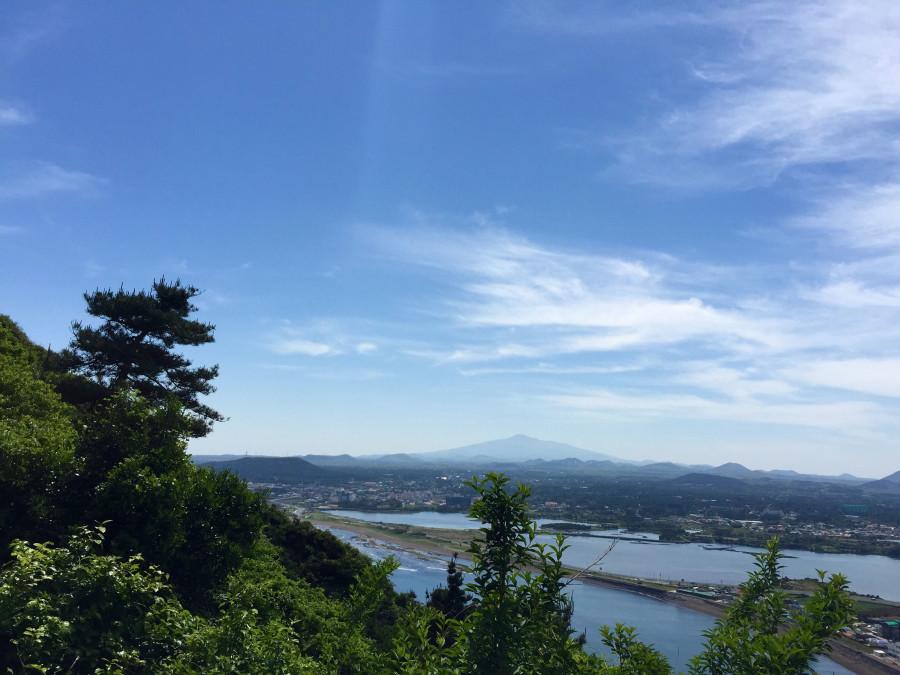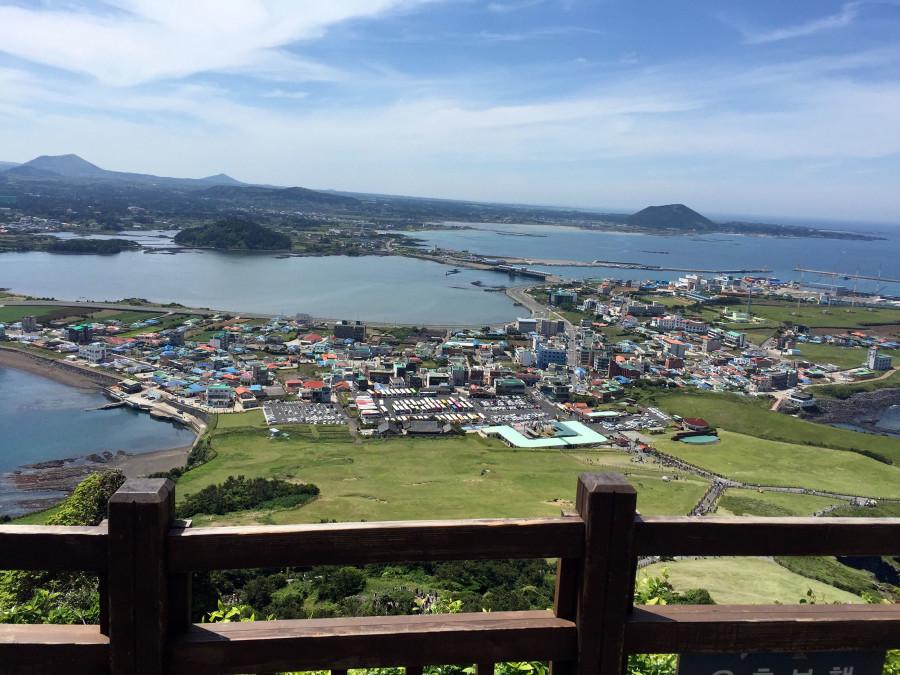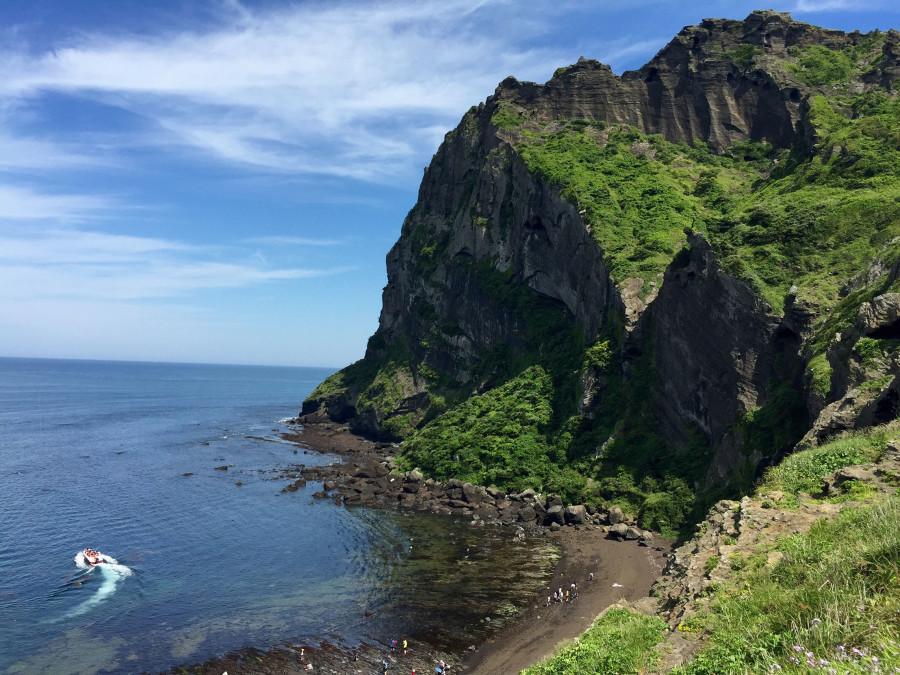Visiting Sunrise Peak on South Korea’s Jeju Island
The cliffs of Sunrise Peak rise up from the sea.
September 8, 2015
Waking up at Yeha Guesthouse is like waking up within a dream. The window was left open all night and the crisp sea breeze gently tussled at the curtains in the dim morning light. Whatever jet lag that remained seemed to melt away at the sight of first light. Calmly, the morning wind waited to be welcomed inside. Standing at the window, the first glimpse of Jeju City came into view. The distant mountains provided a backdrop to the clusters of apartments, restaurants and shops within the window’s gaze. The low hum of early risers sprang to life below and the rhythm of the little neighborhood began to sing. Recycling was being sorted by the islanders who showed great care with this morning chore. Looking out again toward the mountains, the sun began to awaken the colors of the island. The natural greens and vivid blues native to the island were easy to see amongst the colorful salt-water-worn buildings. In this moment it was easy to see that, of all the beautiful places in the world, nothing would surpass the sweet gentleness of this morning waking up to Jeju Island.
“Living in Colorado, I became old and missed the beauty of the island where I grew up,” Yeong, a Jeju Island resident, said. “I moved back to Jeju and now live with my sister. I feel young again and happy.”
Jeju Island is listed as one of the world’s new seven natural wonders and has three UNESCO World Natural Heritage sites: Mt. Hallasan, Sunrise Peak and Geomun Oreum Lava Tubes. Whether waking up to see a sunrise firsthand or hearing an elderly woman’s story of growing up in the beauty of Jeju, the island has a very profound way of striking awe into the hearts of its natives and visitors.

Sunrise Peak comes into view as Laura’s tour bus approaches from Jeju City.
While not very large, 45 miles east-to-west and 19 miles north-to-south, Jeju is packed with volcanic landmarks, a picturesque countryside and numerous beaches. Aside from the majesty of these natural wonders, the island also offers visitors rich ancient traditions and a culture that includes its own dialect and thousands of gods. Dolhareubang, or old grandfathers, are figures of fertility that are seen all across the island and are a favorite icon of Jeju. In fact, the self-governing province uses traits from the grandfather statues in the character “Dorhee” that symbolizes the island. Along with “Dorhee” is “Sorhee,” who represents the island’s haenyeo, the female divers. This unique place draws people to Jeju Island on every level from the beautiful to the intriguing. Waking up on Jeju is more than just getting out of bed; it’s a kick-start to a day filled with adventure.
The smells of gasoline and sea breeze competed for noses at the bus terminal. However, the small market-like shops, with their sweet fresh aromas, were the victors of this scent battle. The sweet, tangy smell of kimchi and of fresh citrus wafting up from the Jeju oranges lured passersby toward small makeshift stands.
The terminal had a worn finish. The golds and greens that once warmed the walls were subdued from the time spent watching the sun shine through the tall glass windows. Worn but not forgotten, it was easy to see that cleanliness was a pillar of virtue in the terminal. The glass windows, both inside and out, freshly sparkled in the mid-morning light and the polished floors gleamed up at them.
The chattering of merchants, tellers and buses was noticeable but not loud. At a ticket counter, friendly Korean women sat behind a large plate of glass and sold bus tickets to locals and foreigners alike. As they thanked their customers, each woman would point in a general fashion to their left directing people to the bus platforms as they handed back tickets and change.
The buses heaved heavy breaths as they came to their stops. Lurching at the platforms, drivers abruptly controlled brakes and allowed passengers on board. When the driver commanded the bus to move again, the bus obeyed. Stopping and starting at each stop along the way, heat would swell inside the bus, engulfing it in waves. The passengers eagerly released the building pressure by opening the windows and encouraging the cool breeze to board.
As the bus drew nearer to the sea, the smell of the ocean and little fisheries while they were casting a fishing line along the narrow streets invited passengers for lunch. In the distance Seongsan Ilchulbong, Sunrise Peak, came into view and the driver once again tamed the mechanical beast and ushered everyone off, leaving no time for pleasantries.

Sunrise Peak stands about 600 feet above the ocean.
Walking from the bus stop to the entrance of Sunrise Peak’s path, travelers began the attempt to trek its steep pathways. However, the sight of the dormant volcano causes one’s body to quickly think about energy and perhaps lunch. When traveling to an island, one should expect seafood and lots of it. Jeju Island is known for its freshly caught sea creatures and fish. Typical Jeju favorites would be abalones, seafood ramen, green tea desserts and fresh raw seafood. For the non-fish eating traveler, chicken and pork can also be found. Eating the fresh seafood and other customary dishes is part of the experience so unless allergies are a concern, try the sometimes wiggly little creatures and enjoy.
After eating a protein-heavy lunch, the trails leading to the top of Sunrise Peak don’t seem as daunting. Quickly you find yourself making the trek alongside many other Korean and foreign travelers alike. Along the steep path are places to capture photos and rest. At these stops, many strangers become friends, swapping stories of their journey to Jeju Island and the experiences so far. Here, huffing and puffing uphill is no excuse to not be friendly.
“The path is steep but everything is worth seeing,” Cihan Choy, a Korean student visiting Jeju, said.
Choy was on a trip with his high school, discovering Jeju Island’s internationally known sites like Sunrise Peak. His English was a bit choppy but he stuck to it, forcing himself to engage with the native speakers he had encountered. This is a great example of both the friendliness found in Korea and the dedication to education that is stressed across the country. Choy spent some time walking with the tourists, practicing his English conversational skills and teaching them a few words in Korean. He answered their questions and commented on the island’s beauty just like everyone else.
“The plants are pretty here. Some are like to the ones found in Korea (the mainland) but most are specific to here,” Choy said.
Trekking along, there are a few places to wander down other paths. These paths lead to closer views of the island’s native plants, flowers and volcanic rock formations. Sunrise Peak is a dormant cone volcano, or tuff, that juts straight up forming a peninsula on the east edge of Jeju Island. Also known as Seongsan Ilchulbong, which translates to “fortress mountain,” the volcanic crater measures almost two thousand feet wide and nearly 300 feet high, and the volcano is rich with plant and animal species. Sunrise Peak was designated one of Korea’s first UNESCO Natural World Heritage sites.
Standing on the last landing on the hill facing the staircase that seems to wind its way up to the sky, the real hike begins. The first dozen steps are easy. Then the weight of gravity becomes apparent but at this point new friends encourage the climb. The rich black rock starkly contrasts with the vivid blue sky and the bright natural greens that surround the stairs. Several landings include beautiful sculptures that were carved by the winds coming off the ocean and the volcanic lava that originated the now hardened rock. These sites give reason to pause on the step trek. By this point, the once smiling friends are focused on their journey and silence falls over everyone.

Visitors to the top of Sunrise Peak can see across miles of Jeju Island from there.
Knowing what you are capable of and interested in is key to planning a stay on Jeju Island. Taking advice from the locals will give the best insight on what draws them to certain places and away from others. Also, talking with an islander is the best way to plan a day off the beaten track. They provide more information than just places to go. They give opinionated reviews of eateries to avoid and tips on how to order at the best restaurants tucked out of many tourists’ vision. When it comes to transportation, bus numbers and landmarks are dealt out heavily during these conversations.
“There are so many things to see you’ll have to narrow your day down,” Kum-Sun, a staff member at Yeha Guesthouse, said. “You need to pick an area and a few things within it to do so you aren’t rushed and can enjoy the moments you have. Besides, it’s easier to stay on one side; the bus numbers to get back are different. The Hyeopjae/Geumneung Beach is my favorite beach but Hamdeock Seoubong Beach and Woljeong Beach are great if you are going to be on the east side of the island. If you stay on the east side bus 701 will take you there and bring you back.”
The gentle sunrise welcome to the island, the aromatic bus terminal, a ride on a mechanical beast and tastes of fresh seafood fuel the overwhelming sense of determination. All the moments that led to this journey up Sunrise Peak blend together, and in this moment the heart of Jeju opens itself up to you. The silence welcomes the sounds of the ocean winds as they whistle their way through the rock statues and trees. These harmonies are followed up by the distant sounds of waves crashing like big cymbals in a percussion section, and hearty notes of laughter rise up from those still closer to sea level. The song Sunrise Peak performs is magnificent and it provides motivation to finish the journey. Suddenly, the sky opens up and you are standing nearly 600 feet above the ocean looking out to the great abyss of deep blue water. In this moment, you realize that you will leave a piece of yourself here on the top of Sunrise Peak. In this moment, you understand why the slogan of Jeju Island is, “The World comes to Jeju, and Jeju goes to the World.”



